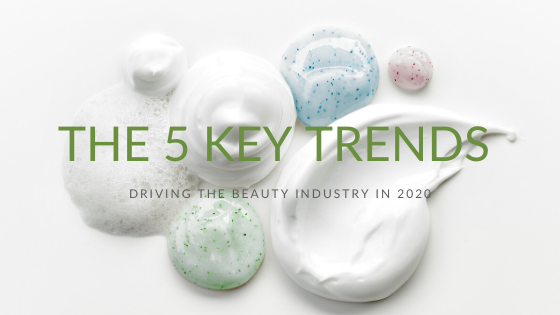Do you have your strategy laid out for #2020? With an expected average growth rate of 6% per year for the next 10 years, the global beauty industry is a very attractive playground to play in. It is expected to value 800 BN USD in 2030! Are you ready to serve your customers and give them exactly what they want? As you know, that is what gets you new customers and keeps your current customers head over heels in love with you. It is what we all want, and need to be successful. Of course you are already staying in touch with your customers and you know them well. But to add a more general, marketwide perspective (to reach the customers you don’t know yet!) the big research reports are a great source of information. It can provide inspiration for new products or marketing angles, to verify and support what you have already planned (well done you!), or simply to fill in the gaps in your already amazing strategy. Either way, you can never have enough market information can you?
So to help you get 2020 off on the right foot we are sharing what we have learned from all the marketresearch we have been able to get our hands on in the past months. To save you time we have summarized it in this 5 point summary of the key market trends in 2020 in the beauty industry. Read through and use this knowledge to your advantage!
Trend #1 – More demand for natural, clean, and sustainable beauty products
Was there ever any doubt? Going strong for many years now, consumers continue to choose for more natural, clean and sustainable beauty products. As much as they are loyal to their conventional products, 66% of consumers say that brands and products that are natural, clean and sustainable can entice them to try something new!
More over, consumers are learning about the difference between natural, clean and sustainable. Nowadays only 25% of consumers believe that natural is the same as organic. This gives a major advantage to the smaller niche brands. As R. Alexandra Keith, CEO of Proctor & Gamble Beauty, said, “If the entire industry switched to organic and natural materials, it would be a problem for the Earth and for food sources.” In other words, sourcing a big enough amount of natural ingredients for a big brand like PalmOlive is a big challenge since there is a limited supply. But if you are a small brand you can relatively easily get enough high quality, rare natural ingredients to enable you to launch a unique and amazing new product(line) that is truly natural, organic and sustainable! Woohooo! Score for the small players!
Trend #2 – Trusted, authentic brands become a lifestyle partner
Consumers are looking for meaning. The desire for natural products is in part because they believe that natural products are more effective and/or better for the environment. However the choice for natural, organic, ethical and sustainable is also very much identity related. It is a cause, it provides meaning, it makes you feel good! People love brands because it reinforces their identity, even if they don’t use them! They are proud to pull a lipbalm from their bag or showcase a pretty body butter jar on their bathroom vanity to show that they care about the environment and make sustainable choices. As such, having a transparent, clear eco and ethical story for your brand is more important than ever before. Brands need to take a stand. You may not appeal to everyone, but the people who do will love you all the more for it.
But beware, make sure you are authentic and truthful! Many brands have landed themselves in hot water in 2019 for greenwashing; making claims about products and their brand that were false. If you don’t have the true story you need to choose a different marketing angle.
Do you wonder how you can share and capitalize on your values in your marketing? Look at TOMs, Caïo and Numi Tea for great examples on creating value through storytelling.
Trend #3 – Inclusive beauty
In 2017 Fenty coined the term “inclusive beauty” and it has been the buzzword ever since. In the new decade this trend will continue the push to develop more products for underserved groups. Think of men’s products, gender fluid products, and products for specific underserved ethnicities. But also for specific age brackets like perimenopausal and menopausal women, children, teens and babies. People no longer want a one size fits all product. They know that they are unique and special, and want a product that meets their specific needs. There is even a movement towards totally customized individual beauty products, made on order!
This need to be included and acknowledged also reflects in the actual marketing. There is a distinct desire for it to be real so that people can recognize themselves in it. Research shows that accurately and positively reflecting age is number 1 on peoples’ marketing wish list (54%), followed by real, untouched images that show true beauty; cellulite, tooth gaps, scars, gray hair, wrinkles and all. Embracing the beauty in all body sizes (49%), facial features (47%), race/ethnicity (42%), skin color (40%) and genders (40%) are also important.
As people want to see themselves, marketing becomes much more personal. People are less and less influenced by the traditional marketing campaigns like TV and magazine campaigns that are perceived to “sell” to them. Rather, the people closest to the consumer have the most profound influence in an individuals’ beauty routine choices, especially friends (50%), mothers (49%) and sisters or other family members (41%). To compare, these close personal contacts are way more influential than magazines (27%), online videos (27%) and even instagram and other social media (25%).
Trend #4 – Suppliers at heart!
Less about marketing and more about business operations is trend#4. Skincare products are more and more seen (and marketed) as food the skin, and similar with haircare products for example. Given that, it is no wonder that the line between food and beauty products keeps fading, with more and more food products being used as high value ingredients in beauty products. Just think of olive oil, turmeric, and coconut oil.
As mentioned before, truly natural and organic ingredients, especially those that grow in the wild, have a limited supply. A situation that can be even become more complicated due to environmental factors. For example during 2019 jojoba oil and rosehip oil supplies were impacted because of global crop shortages. This has heavily impacted brands that rely on those ingredients. As a result, ingredient sourcing is a major concern for all beauty brands small and large.
Beyond the basic availability of the product is also the story surrounding ingredients. Linked to that authentic brand messaging that we spoke of before, there is more and more attention to ingredient supply chains. Just think of the NIKE and H&M supply chain scandals of the past. Do your ingredients come from truly ethical and sustainable sources? Do you know?
To mitigate these risks many manufacturers and brands are choosing to build closer relationships with their ingredient suppliers. This can is done by supplier visits and audits, and sometimes going as far as actually purchasing them to have total control. No matter how you do it, suppliers are no longer seen as interchangeable or at arm’s length. For key ingredients that add value to your brand and products you need to keep them close and know them.
Trend #5 – Beautiful technology
There seems to be an app for everything these days and beauty is no exception. Varying from apps and tech tools to provide skin analysis, to beauty routine recommendations, and ingredient label readers to providing insight in traceability and production processes. Tech is entering the beauty industry big time. So much that L’Oreal has set up the Open Innovation Platform; an inhouse incubation program dedicated to the integration of tech in beauty! So see how it can add value to your product for your customers.
On a side note: Do you know where you want to go with your business? A noticeable trend is also M&A within the beauty industry. In 2019 there have been several high-profile brand acquisitions. Unilever acquired J-beauty brand Tatcha and L’Occitane bought skincare brand Elemis for $900M. And in October, Shiseido purchased cult “clean clinical” skincare brand Drunk Elephant for $845M.
Of course there are other smaller trends as well including the undeniable move towards sustainable packaging, and the rising dominance of new sales channels such as through apparel retailers and online platforms. Interesting newer trends are also the waterless beauty movement and label simplification.
The beauty industry is ever evolving in response to ever changing customer demands. It is up to us to understand our customers and push our limits of what value we can add and create in 2020! If you have any questions please feel free to comment or get in touch on any of our other platforms. We look forward to hear from you and help you succeed in the new decade!






Leave A Comment